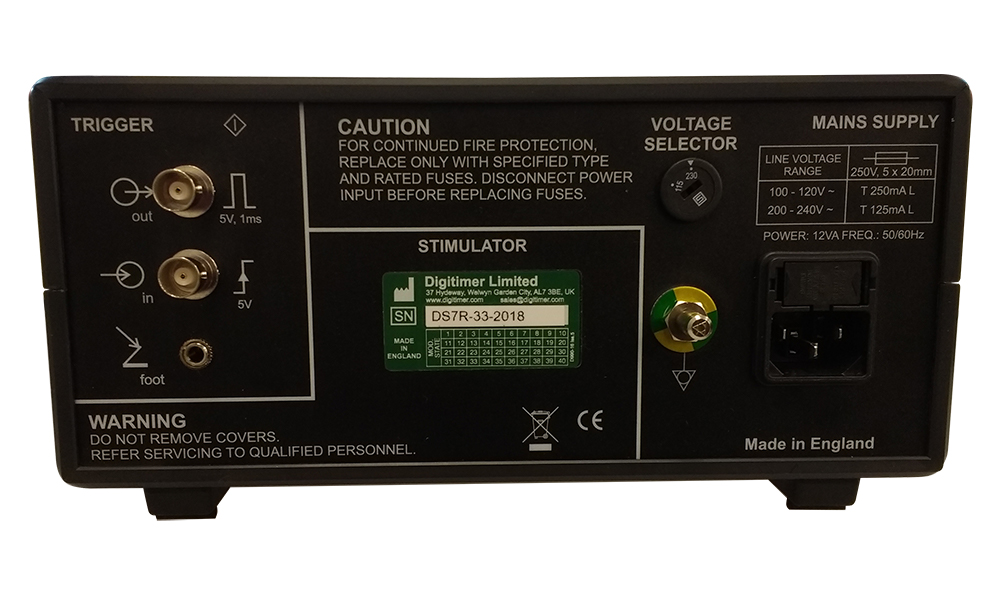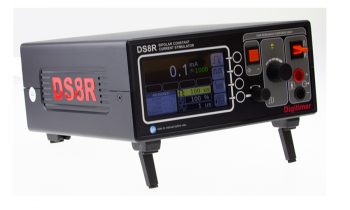Description
DESCRIPTION
Suitable as a general purpose electrical nerve or muscle stimulator for peripheral stimulation in human research studies, the DS7R provides up to 999mA constant current high voltage pulses of brief duration for trans-cutaneous stimulation during investigation of the electrical activity of nerve and muscle tissue. The DS7R is specifically recommended for human research applications where its high voltage, high current and flexible pulse duration capabilities permit stimulation of large muscle groups or deep nerves/nerve roots.
High Current & Flexible Pulse Duration Options
The DS7R Constant Current Research Stimulator is based on and almost identical to the medically approved DS7AH. The output current is continuously variable over two ranges of 0 to 99.9mA and 0 to 999mA, but where it differs is in relation to the available pulse durations. With the DS7AH, the maximum permitted pulse duration is 200µs, while the DS7R allows pulses of up to 2ms*. Because this greater flexibility is only required in human research applications, the DS7R is NOT medically approved and is marketed for human or animal research use only.
Safe for Human Research Use
In relaxing the pulse duration limits, the maximum pulse energy the DS7R can deliver has increased slightly. While this takes it beyond the 50mJ limit imposed by the international standard applicable to evoked potential stimulators (EN60601-2-40), it is well within the 300mJ limit applicable to electrical stimulators in human therapeutic use (EN60601-2-10).
Like the DS7A and DS7AH, the DS7R includes an alternating polarity mode to prevent polarization of the stimulation site and potentially harmful electrolytic effects of longer periods of stimulation.
The DS7R can be triggered by an external device such as our new DG2A Train/Delay Generator. For human research applications requiring greater flexibility in terms of stimulus parameters and/or external control, please consider our new DS8R Biphasic High Voltage Constant Current Stimulator. For applications that require a medically certified stimulator, please refer to our DS7A/AH High Voltage Constant Current Stimulators, the DS5 Bipolar Stimulator or our D185 MultiPulse Transcranial Cortical Stimulator.
* The actual achievable current is subject to the set current amplitude, frequency of stimulation and load impedance/available compliance voltage.
GALLERY
PUBLICATIONS
As the DS7R is a new product there are only three publications at this time, but this list will be extended as more work is published.
Brownstein, C. G., Espeit, L., Royer, N., & … (2021). Reductions in motoneuron excitability during sustained isometric contractions are dependent on stimulus and contraction intensity. Journal of Neurophysiology. Retrieved from https://doi.org/10.1152/jn.00070.2021
Varesco, G., Royer, N., Singh, B., Parent, A., Féasson, L., Lapole, T., … Rozand, V. (2021). Reliability and agreement of a dynamic quadriceps incremental test for the assessment of neuromuscular function. Journal of Electromyography and Kinesiology, 56. https://doi.org/10.1016/j.jelekin.2020.102503
Neige, C., Grosprêtre, S., Martin, A., & Lebon, F. (2020). Influence of voluntary contraction level, test stimulus intensity and normalization procedures on the evaluation of short-interval intracortical inhibition. Brain Sciences, 10(7), 1–16. https://doi.org/10.3390/brainsci10070433
Last updated 6th April 2021
ACCESSORIES
Supplied
- Mains (Power) lead
- Operator’s Manual
Recommended
- D185-HB4 Output Extension Cable
- D185-OC1 Output Connection Plugs
- DG2A Train/Delay Generator
- DS7A-HS1 Hand-switch for remote triggering
- Electrodes & Accessories
FAQS
The DS7R has the same maximum current output as the DS7AH, but the more flexible pulse duration settings of the DS7A (50µs to 2ms), making it more versatile than the DS7AH. However, because the maximum energy that the stimulator can deliver is in excess of 50mJ, which exceeds the EN60601-2-40 standard for evoked potential stimulators, we are not able to give the DS7R a medical CE mark against that standard. Instead, the DS7R is offered for human research applications, where more flexible pulse parameter settings may be required.
No, in order for the DS7AH to be granted medical device status, it is necessary for us to restrict the pulse energy to a maximum of 50mJ. If you require stimulation pulses in excess of 100mA with durations of >200µs, the DS7R is the only device we can offer, but while safe for human research use, it is not a medical device.
No, the DS7R does not have this capability, but our new DS8R stimulator does offer external control via Windows PC software, an embedded API or an analogue voltage input (to define pulse amplitude).










